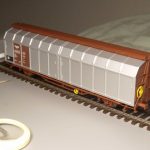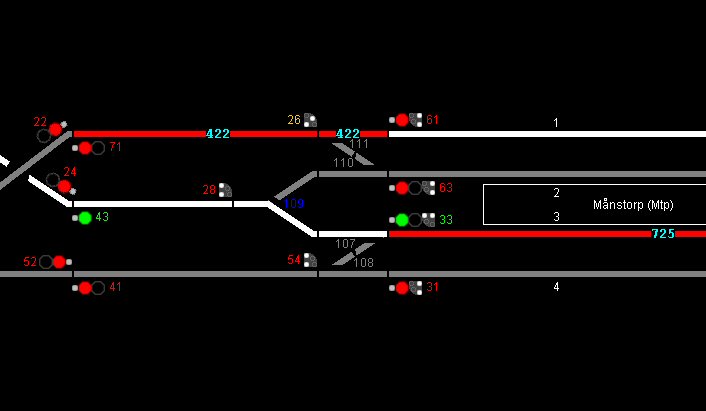Our News
February was quite a busy month, for the wrong reasons. The employment was being wound down (not enough orders coming in) and being on a time contract, being sent home (or just told not to come in) became very much the rule. This provided time to apply for better employment (and accommodation), and in order to break up the stress, a lot of modelling!
T21 87 was reassembled in a whole day! Only five things fell off during this process, two of them cab windows. Ordinarily, one should not need to remove the B-end motor cover (unless access to the DCC loudspeaker is required), and having been glued together by Heljan, we can aver that it is impossible to get off without damaging it! The fibre-optic rods go from receptacles in the body into the chassis, horizontally; but the body can only be removed vertically! The trick was to prise off the (glued on) front panel and try not to lose the upper lamp pieces! We were fortunate in that only one tiny part got lost, and that all five lamps (if you include the red) at this end work, albeit, one of the whites dimly (which is not inauthentic)! The A-end was much easier, though again there was damage to the fibre-optic rod to one of the lamps because it is fitted horizontally in a body/chassis that separates vertically! Gluing it back on was not a viable option, but pressing it into the receptacle in the chassis for its ‘mate’ to meet up with it when we mounted the body was better. (To remove this end, the part of the body nearer the cab needs to be inclined as per Heljan’s instructions, to enable the tabs to clear the chassis; but tilt it too much and the rods break!) This is being typed whilst we wait for glue to dry before refitting the last handrail (to a step that was one of the items that fell off); but there is no guarantee that this will go back on without issue or complication! [Stop Press: Yes, sure enough, the steps fell off, the nearby buffer beam fell off, and during handling to put these right, the exhaust stack fell off. No other manufacturer could make a model with so many ‘issues’!]
The N 1304 steam loco had its couplings refitted, with the Roco receptacles mounted onto plastic blocks (but not with the kinematic mechanism). At the front, this sat in a small gap between the frames and behind the lighting resistor that was behind the buffer beam. At the back, there was a lot of space, so a plastic block was bolstered by some washers, but it all fits in quite nicely. There was a plan to replace the buffers with the sprung ones that we had recently acquired; but we decided that this was less urgent, and that when it is done, we will re-seat the headlamps at the back so that they don’t overhang the buffers!
When BC4R 5467 was delivered, two drainage pipes had been knocked off. Comparing this with number 5476, we were able to see where they should be fitted, and this was finally done. Examining this carriage afterwards, we noticed that it too, has M84S bogies with real coil springs, but these are less flimsy than on the newer A7R and B7R models, and not so obvious.
One of the Ugkkpp wagons, being so short, has been used as a test model for coupling compatibility tests with the steam loco above, and with the T21 and T45 diesels; but we found that it was much more delicate than we had realised, and a pair of components near one of the wheel-sets had got knocked off. These were refitted, and all four of these wagons are now declared unsuitable for ‘test’ work!
Our relatively new (Norwegian) NSB ‘Hbikks’ van was finally fitted with its required handwheels, small ones for the parking brakes, and larger ones for the opening doors. These hadn’t been missing; they were in a bag with the model. We just needed to find the time to fit them!





Manufacturer News
Some updates have appeared from HNoll (one seemingly backdated) in which Rickard takes stock of events over the last six years. To date, HNoll has sold roundly 5,700 sleepers and couchettes in 51 different configurations (liveries and running numbers), 2,600 restaurant carriages in 18 configurations, and 9,300 ordinary seating carriages in a presently undetermined number of configurations, with more to follow. However, despite these latest carriages selling in the greatest number, it represents roundly 50% of those received from China and sales have, after the initial rush, stopped dead. Rickard wonders if they were not as interesting as models as he had hoped (given that these are the closest competition to the Roco models), or if it is for economic reasons. We are convinced beyond doubt that it is for economic reasons. Food prices in Sweden have almost doubled in the last year; electricity costs have more than doubled. People are struggling and having to divert hobby money to basic survival. And to a greater or lesser extent, this is true around most of Europe regardless of political position.
Since the start, HNoll’s operations have been 100% based on home loans and other favourable loans. This was because the interest rate had been very favourable for a long time. The situation has clearly changed for the worse financially as the monthly cost with interest has noticeably increased. The revenue is eaten up by the interest and there is great uncertainty about expected sales volumes. Volumes need to be kept at a high level to generate enough revenue which have the risk of turning into loss if sales volumes are less than expected. There may need to be a halt in tool manufacturing as the loans must be prioritised.
The ‘generation-2-blue’ (A7/B7) carriages that were missing in the latest delivery should arrive together with the B4/BF4/BF7 carriages in the summer. Maybe also the long-awaited Blue-X carriages, but that depends on the sale of the carriages in stock. There is currently not enough money to bring the Blue-X carriages into production this spring. (They have, among other things, differently opening windows!) It is hoped that the special carriages (S1, etc) can be delivered in the Autumn.
It is of course, our hope that Rickard is able to keep the production running, even if there has to be a delay with the next round of models. But people’s private economies need to improve before this can happen; the interest and other financial problems that Rickard has experienced, have also been experienced first hand, by a vast majority of the Swedish population (and his other worldwide customers). For the FLMJ, we are looking forward to the B4; and hoping for B2, UA7X (aka AFM7), and series 1 A7/B7. (Assuming that we haven’t misinterpreted an earlier comment by HNoll, we are also hoping for one R4 (which would be original brown without the InterCity chevrons), to go into one of the night trains; but we fear that might be a misunderstanding!)
In other news, and really too modern for the FLMJ’s station car-parks, PCX87 is to produce a 2019 year model Volvo V60 in four different colours, in H0-scale.

Other News
Forever breaking the tiniest drill bits that we have, we are now experimenting with 0,2 and 0,5mm bits made by Tamiya; which have a 1mm shank. This prevents us drilling too deep with the finer bits and will maybe last a lot longer. Previously, we had been given something similar by a dentist friend, but the dental bits have much longer fine sections. Time and usage will tell.
We have searched for a long time for an official meaning of the letter ‘h’ in the wagon type ‘Uh’. In ‘SJF 637’ from 1971, we have found that it simply means, “for liquid and gaseous substances”, or in other words, ‘tank wagons’. We have updated the relevant section of the website!
LEG’s film series, “Svenska Tåg” is no longer available in the shops, sadly; the DVDs can only be purchased from one ‘approved’ supplier. Thus ends our association with them (we have editions 1 to 51). We will not endorse any action that potentially leads to the closure of Railway hobby related shops.
Behind the Scenes
Mini-Series around the FLMJ; C: The Newsletter, AJ-Nyheter
AJ-Nyheter was a less glossy and more formal newsletter created for the people who were regularly active upon the railway. Instead of book and video reviews, this would have explanations to the changes in the operating rules, servicing instructions for the various models, and anything that was more appropriate to the operation of the Railway than the promotion of it. It also promoted the same for the club’s other activities, including the outings and exhibition layouts (Köpingsvik and Steninge, for example). This newsletter changed format several times, from A4 printed single sheets, to staple-bound magazines, and various alternatives in between! And whilst the main journal was leaning towards colour production, this one certainly wasn’t.
With the closure of the Railway, this newsletter was naturally obsolete. However, in fact, it had stopped in production earlier because it was considered superfluous; internal issues were best talked about, not written; and any written communication that was necessary was enacted by email. It is envisaged, that when the new railway does get started, an online presence will be more likely, and that AJ-Nyheter will not go back into production. Online communication already exists among some of the Friends of the Railway, who are keen to build their own Swedish model railway dioramas, and naturally have our full support. One key area for this is the Swedish equivalent of eBay, where some very good models of Swedish rolling stock often appear, but the sellers will ship only to Sweden, or the EU, or the EEA (and some couriers will not operate in the UK now). So, delivery is taken here in Sweden, and we arrange (with the Friend) for onward delivery (or collection during a visit)!
So now, two key journals have been stopped, ‘FLMJ-Nytt’ and ‘AJ-Nyheter’, and both are very unlikely to restart; but that’s not bad news! We abhor change for change-sake; but change for improvement has always been encouraged and as we will discuss during the year, we are taking advantage of this quiet spell to prepare for a new means of printed communication in support of our online presence,
Next month: our Annual Review.
And finally: We aim to post our updates on the first day of the month following (February’s news on March 1st, for example). So be aware that if looking through archived news, our host records the archive date as the ‘date published’, not the date that the news is about. (Thanks to one of our readers for this enquiry.)










